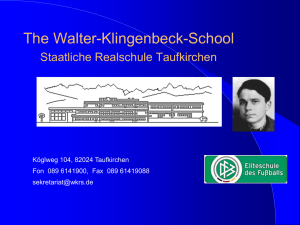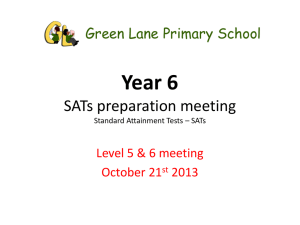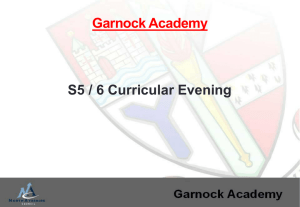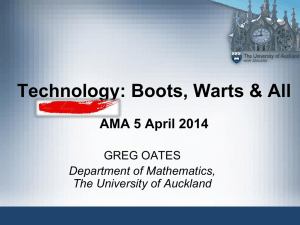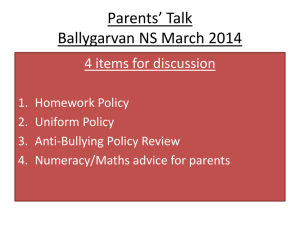Maths - Assessment and Differentiation (Module
advertisement
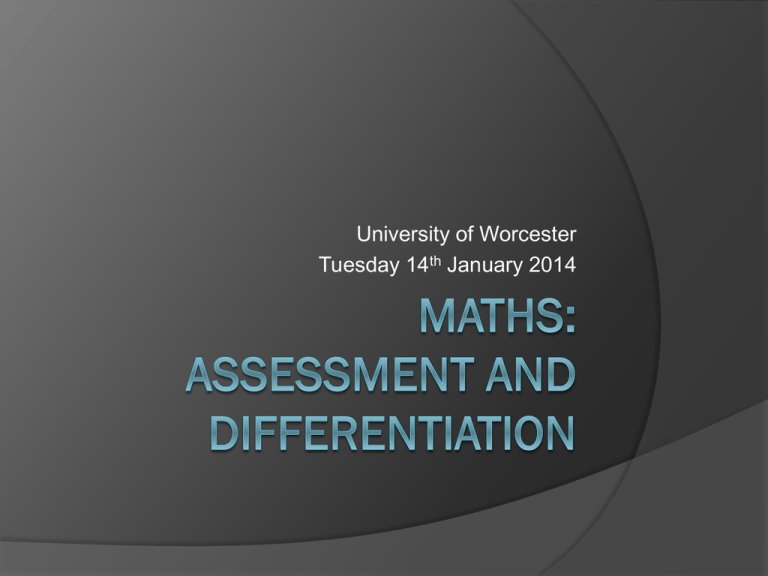
University of Worcester Tuesday 14th January 2014 Headteacher not Headmaster I teach Maths most days either in groups or whole classes “The school is led from the classroom” Emergent Maths In Somerset the NWP (National Writing Project) developed What is Emergent Maths? Key Features of Emergent Writing The writing “emerges” from the child The child is treated as a “writer” not an empty vessel that needs filling The principle of the child taking “The Mantle of The Expert” rather than the teacher At its heart lies the confidence and selfesteem of the child Pedagogical Homogeneity “Pedagogy trumps curriculum every time” (Dylan Wiliam) You cannot teach with pedagogical inconsistency What is Emergent Maths? The Maths springs from the child 4 Smarties shared between 3 toddlers in 1.33 recurring but they all understand the concept of division! What is Emergent Maths? It is built on the principle that: All children come to school with a knowledge of number They come to the class as a fledgling Mathematician Therefore… Maths can emerge What is Emergent Maths? “Mantle of the Expert” The subliminal message of: I am the teacher and I am cleverer than you You are the pupil you know nothing. Therefore I must teach you through transmission What is Emergent Maths? The starting point for me was always the issue of Confidence and Self Esteem The child who sees himself as a learner will learn – intrinsic motivation What is Emergent Maths? Research is now starting to show that success in learning is down to “how” we learn as well as “what” we learn – Brain plasticity If we learn in one context or one style then it will impact on our ability to transfer learning What is Emergent Maths? What is Emergent Maths? What is Emergent Maths? What is Emergent Maths? Exploring the Concept of Pi That “eureka” moment of discovering a theorem Low Threshold, High Ceiling “Low Threshold, High ceiling tasks have easy access but lots of potential” Quote from Nrich website The Ultimate Open Ended Task Scaffolding a Task The 100 Square provides a slightly more structured activity Scaffolding a Task “All the numbers in the first column end in 4” The teacher remains in control of the emotional response Scaffolding a Task “The opposite corners of the small square add up to the same total” Where do we go next? Scaffolding a Task What about the top and bottom numbers? What do you notice about the middle number? Scaffolding a Task Will it work on any 9 grid anywhere on the 100 square? What do you think will happen on a 16 grid square? Scaffolding a Task But the best question is… So… What could we explore from that? Scaffolding a Task Often a mixture of modelling ways forward for exploration and allowing children to follow the Maths for themselves Scaffolding a Task Also a mixture between class led and class directed e.g. “Let’s all test Tom’s theory and choose our own 9 square and see if it works” and then further individual exploration Mathematical Enjoyment The problem with how Maths is usually taught is that it is taught in Black and White and it should be a subject of glorious techni-colour Maths is Right or Wrong Too often Maths is taught in the sphere of right or wrong Especially if used in a didactic approach where the emphasis is… “I will show you… now do you get it?” Maths is Right or Wrong The truth is 2+3=6 is wrong But so is; “Wun day I whent too miy house” Emergent Writing focused on treating the child as a “real” fledgling writer. Why can’t we do the same in Maths? Enjoyment of Maths According to Jo Boaler children’s enjoyment of the subject (especially girls) plummets when they focus on dry, taught procedures only and aren’t allowed to explore numbers for greater understanding Enjoyment of Maths Instructional Maths “Rules without reasons” Enjoyment of Maths A few years ago I asked our Year 6 children which subject they enjoyed most Maths or English? “Maths because it is more creative” What is Emergent Maths? The title of a book by Sue Atkinson! Teacher Skills To teach emergently the skill set changes No Longer… “The Sage on the Stage but the Guide on the Side” Classroom Keys Culture of Learning Is it better to get work right or wrong? The story of Zoe HayMcBer study: Culture Secure Subject Knowledge Williams Report Maths and Understanding Maths is about understanding What is 13.5% of 3,245? What is a percentage? Maths and Understanding No-one could see the practical use as to why schools SAT scores were compared by percentages rather than raw numerical data “Maths is a tool to solve problems not an end it itself” Jo Boaler Dialogue is the Key Reasoning and Dialogue All Maths should be “constructed” by the children themselves Constructed through dialogue Socio-Constructivism Built in Assessment Dialogue provides built in, up to the minute assessment of where children are up to Learning Built on that Assessment There cannot be an angle at the bottom of the Kite because angles look like this… Learning Built on that Assessment Learning Built on that Assessment The context had come from a discussion about the internal angles of a shape Learning Built on that Assessment Is this an “internal” or “external” angle? An Upside Down Triangle! What is the Fraction? What is the Fraction? The power of Schema All done with no understanding whatsoever! Understanding “Any individual task can be performed correctly without understanding” Hiebert and Carpenter 1992 Draw 2 lines to complete a square Follow the Children The art of the teacher in this style of teaching is to follow the children and avoid the cul-desacs Teacher Questioning Assessment and the Learning Objective Assessment is there to assess learning In which case we need to ensure that the learning is watertight Assessment and the Learning Objective Learning about angles… Really???!!! The learning should drive the assessment What is the Learning? Measuring or Ratio and Proportion? What is the Learning? So what will the assessment be? Using Similes This does not teach how to write good similes “What makes a good simile?” Why is this a good one?” Richard Skemp Instrumental Understanding – Skemp describes this as “rules without reasons” Relational Understanding - Skemp describes this as “knowing both what to do and why” and the process of learning relational mathematics is “building up a conceptual structure” What is Emergent Maths? What is Emergent Maths? I thought I understood this?!! Emergent Maths Emergent Maths tackles “Relational Understanding” and on the whole can be undertaken mainly through Mixed Ability, Whole Class teaching Whilst not as important “Instrumental Understanding” needs clear Differentiation Differentiated Options Aye There’s the rub (Hamlet Act 3 Scene 1) The majority of research shows clearly that formal Setting and Streaming has minimal impact on attainment Where progress is made it is usually with the more able but nearly always at the expense of all other groups of children Jo Boaler Jo Boaler “88% of children placed in ability groups at age 4 remain in the same groupings until they leave school. The Influence of Ability Grouping Dylan Wiliam It’s not which school but which set you’re in that matters Progress across schools was similar if not the same but within schools remained markedly different Hattie – Visible Learning Ability Grouping/Streaming 0.12 Comparing attainment and equity effects Within class Grouping Children put in formal ability groups 0.18 So should we ever group children? Just a Question… What is ⅔ of ¾ of 11? Just a Question… The Challenge and the learning is in the level of the question Differentiated Options Fluid Grouping The principles and understanding can be the same but the differentiation can be in the task as an outcome Fluid Grouping So we might teach the mechanical principles from this example But allow the children to explore any of the following: Differentiated Options The Key to Fluid Groups The children need to understand that… 1. 2. 3. 4. Learning is about challenge and therefore the possibility of getting things wrong The “Zone of Proximal Development” The Box of Tissues and the yawn Permission to take control of their own learning e.g. More able design decimal examples? Where do worksheets fit in? Look, I have spent all last evening designing this worksheet so it is just at your level because you are too thick to work out what you need and also I want to rip every ounce of empowerment for your own learning out of you They don’t!! You numpty! This morning it all clicked for me and if you let me loose I could make staggering progress which would impress the OFSTED inspector sitting at the back Moving Groups The issue of the 88% is that in “formal” setting it is hard to structurally move groups – hence the stagnation of progress Fluid groups allow children to pitch in at their own level of ability and confidence And Finally… Assessment returns Instrumental Maths A sum in a book How many of them? Relational Maths A sentence written in a book? Emphasis on Mathematical vocabulary Discussion Time Thank Goodness he’s shut up now we might get a chance to get a word in edgeways!! Any thoughts or comments on the Presentation, The article “Implementing Curriculum 2014” or on The Wyche Calculation Document

